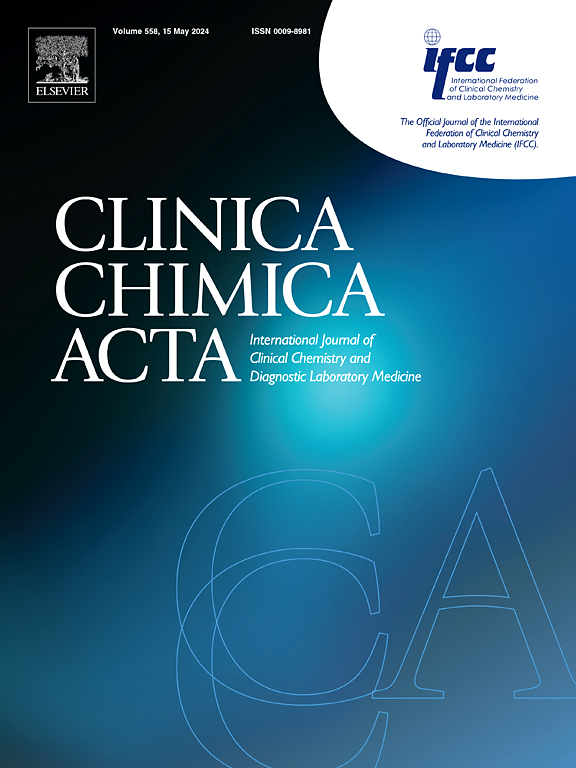Feasibility evaluation of big data algorithms for establishing serum protein electrophoresis reference intervals using Hoffmann and refineR methods
IF 3.2
3区 医学
Q2 MEDICAL LABORATORY TECHNOLOGY
引用次数: 0
Abstract
Background
Serum protein electrophoresis (SPE) is essential for diagnosing monoclonal gammopathies and a variety of other diseases. Despite its importance, there is a scarcity of SPE parameter reference intervals (RIs) derived from large datasets. This study seeks to fill this gap by establishing sex-specific RIs using Hoffmann and refineR algorithms and assessing the feasibility of these methods.
Method
We utilized two health check-up population databases to create a reference and a validation set. The reference set included 52,293 individuals with outlier removal via the Tukey method. Variance component analysis was used to evaluate the impact of sex and age on SPE parameters. The Hoffmann and refineR algorithms were applied to establish RIs, with the bias ratio method comparing RI differences. Validation data from differing timeframes helped assess the RIs’ reliability and utility. Moreover, we juxtaposed our RIs with previous studies to identify potential disparities.
Results
Sex-specific RIs were established using the Hoffmann and refineR algorithms, with high consistency between the two algorithms, except for a slight difference in upper limits (ULs) of α1-globulin and β1-globulin. Additionally, there are sex differences in RIs for α2-globulin, β2-globulin, γ-globulin, and Albumin. In the validation analysis, all established RIs passed verification, except for RIs determined by refineR for female α1-globulin and male β2-globulin.
Conclusion
This research highlights the critical impact of sex on SPE RIs and the need for tailored RIs in distinct clinical environments. The utility and feasibility of the Hoffmann and refineR algorithms for creating these customized intervals are effectively demonstrated.
利用Hoffmann和refineR方法建立血清蛋白电泳参考区间的大数据算法可行性评估
背景:血清蛋白电泳(SPE)是诊断单克隆伽玛病和其他多种疾病的必要手段。尽管它很重要,但从大型数据集中获得的SPE参数参考区间(RIs)却很少。本研究试图通过使用Hoffmann和refineR算法建立性别特异性RIs并评估这些方法的可行性来填补这一空白。方法:利用两个健康体检人群数据库分别建立参考集和验证集。参考集包括52,293个个体,通过Tukey方法去除异常值。采用方差成分分析评价性别和年龄对SPE参数的影响。采用Hoffmann和refineR算法建立RI,并用偏置比法比较RI差异。来自不同时间框架的验证数据有助于评估RIs的可靠性和实用性。此外,我们将RIs与之前的研究并置,以确定潜在的差异。结果:采用Hoffmann算法和refineR算法建立了性别特异性RIs,除了α1-球蛋白和β1-球蛋白的上限(ULs)有轻微差异外,两种算法的一致性较高。此外,α2-球蛋白、β2-球蛋白、γ-球蛋白和白蛋白的RIs也存在性别差异。在验证分析中,除细化器测定女性α1-球蛋白和男性β2-球蛋白外,所建立的RIs均通过验证。结论:本研究强调了性别对SPE RIs的关键影响,以及在不同临床环境下定制RIs的必要性。有效地证明了Hoffmann和refineR算法用于创建这些自定义区间的实用性和可行性。
本文章由计算机程序翻译,如有差异,请以英文原文为准。
求助全文
约1分钟内获得全文
求助全文
来源期刊

Clinica Chimica Acta
医学-医学实验技术
CiteScore
10.10
自引率
2.00%
发文量
1268
审稿时长
23 days
期刊介绍:
The Official Journal of the International Federation of Clinical Chemistry and Laboratory Medicine (IFCC)
Clinica Chimica Acta is a high-quality journal which publishes original Research Communications in the field of clinical chemistry and laboratory medicine, defined as the diagnostic application of chemistry, biochemistry, immunochemistry, biochemical aspects of hematology, toxicology, and molecular biology to the study of human disease in body fluids and cells.
The objective of the journal is to publish novel information leading to a better understanding of biological mechanisms of human diseases, their prevention, diagnosis, and patient management. Reports of an applied clinical character are also welcome. Papers concerned with normal metabolic processes or with constituents of normal cells or body fluids, such as reports of experimental or clinical studies in animals, are only considered when they are clearly and directly relevant to human disease. Evaluation of commercial products have a low priority for publication, unless they are novel or represent a technological breakthrough. Studies dealing with effects of drugs and natural products and studies dealing with the redox status in various diseases are not within the journal''s scope. Development and evaluation of novel analytical methodologies where applicable to diagnostic clinical chemistry and laboratory medicine, including point-of-care testing, and topics on laboratory management and informatics will also be considered. Studies focused on emerging diagnostic technologies and (big) data analysis procedures including digitalization, mobile Health, and artificial Intelligence applied to Laboratory Medicine are also of interest.
 求助内容:
求助内容: 应助结果提醒方式:
应助结果提醒方式:


